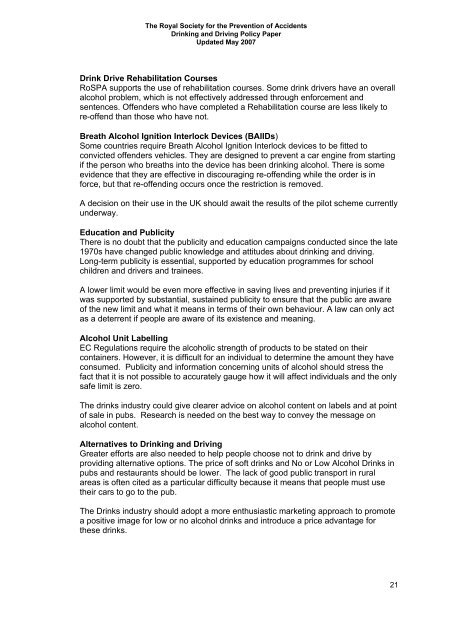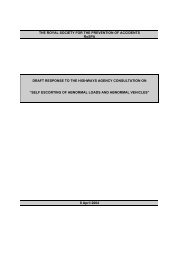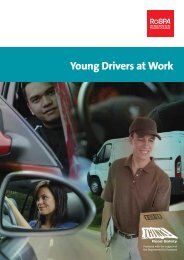RoSPA Drinking and Driving Policy Paper 2007
RoSPA Drinking and Driving Policy Paper 2007
RoSPA Drinking and Driving Policy Paper 2007
Create successful ePaper yourself
Turn your PDF publications into a flip-book with our unique Google optimized e-Paper software.
The Royal Society for the Prevention of Accidents<br />
<strong>Drinking</strong> <strong>and</strong> <strong>Driving</strong> <strong>Policy</strong> <strong>Paper</strong><br />
Updated May <strong>2007</strong><br />
Drink Drive Rehabilitation Courses<br />
<strong>RoSPA</strong> supports the use of rehabilitation courses. Some drink drivers have an overall<br />
alcohol problem, which is not effectively addressed through enforcement <strong>and</strong><br />
sentences. Offenders who have completed a Rehabilitation course are less likely to<br />
re-offend than those who have not.<br />
Breath Alcohol Ignition Interlock Devices (BAIIDs)<br />
Some countries require Breath Alcohol Ignition Interlock devices to be fitted to<br />
convicted offenders vehicles. They are designed to prevent a car engine from starting<br />
if the person who breaths into the device has been drinking alcohol. There is some<br />
evidence that they are effective in discouraging re-offending while the order is in<br />
force, but that re-offending occurs once the restriction is removed.<br />
A decision on their use in the UK should await the results of the pilot scheme currently<br />
underway.<br />
Education <strong>and</strong> Publicity<br />
There is no doubt that the publicity <strong>and</strong> education campaigns conducted since the late<br />
1970s have changed public knowledge <strong>and</strong> attitudes about drinking <strong>and</strong> driving.<br />
Long-term publicity is essential, supported by education programmes for school<br />
children <strong>and</strong> drivers <strong>and</strong> trainees.<br />
A lower limit would be even more effective in saving lives <strong>and</strong> preventing injuries if it<br />
was supported by substantial, sustained publicity to ensure that the public are aware<br />
of the new limit <strong>and</strong> what it means in terms of their own behaviour. A law can only act<br />
as a deterrent if people are aware of its existence <strong>and</strong> meaning.<br />
Alcohol Unit Labelling<br />
EC Regulations require the alcoholic strength of products to be stated on their<br />
containers. However, it is difficult for an individual to determine the amount they have<br />
consumed. Publicity <strong>and</strong> information concerning units of alcohol should stress the<br />
fact that it is not possible to accurately gauge how it will affect individuals <strong>and</strong> the only<br />
safe limit is zero.<br />
The drinks industry could give clearer advice on alcohol content on labels <strong>and</strong> at point<br />
of sale in pubs. Research is needed on the best way to convey the message on<br />
alcohol content.<br />
Alternatives to <strong>Drinking</strong> <strong>and</strong> <strong>Driving</strong><br />
Greater efforts are also needed to help people choose not to drink <strong>and</strong> drive by<br />
providing alternative options. The price of soft drinks <strong>and</strong> No or Low Alcohol Drinks in<br />
pubs <strong>and</strong> restaurants should be lower. The lack of good public transport in rural<br />
areas is often cited as a particular difficulty because it means that people must use<br />
their cars to go to the pub.<br />
The Drinks industry should adopt a more enthusiastic marketing approach to promote<br />
a positive image for low or no alcohol drinks <strong>and</strong> introduce a price advantage for<br />
these drinks.<br />
21
















